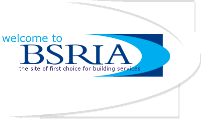Structured cabling has been growing fast in the UK, but is this trend set to continue? BSRIA's Lone Hansen identifies the drivers for growth and explains the potential for intelligent infrastucture management systems:

As Figure 1 shows, only Germany is larger than the UK in Europe. This is due to shielded cabling having a higher value in Germany compared to the UK's preferred option of unshielded twisted pair (UTP).
Market conditions:
The UK market value has been flat for some years after a relatively significant decline between 2001 and 2003, and the suppliers are in fierce competition to maintain or increase their market share.
The market went though a dramatic change in 2001 when Mayflex (at that time the third largest distributor in the UK) launched its Excel range as the first distributor with a low-cost private label. Other distributors have followed Mayflex's example and started importing low-cost systems from Asia.
The distributor brands account for 12% of the UK market. Most distributors, with the exception of Anixter, have their own label. The products are sourced from a number of Asian and local suppliers.
The UK is also characterised by being a leader in terms of uptake of new technologies. This is driven by clients in the financial sector.
Intelligent infrastructure management:
Intelligent infrastructure management describes software-based systems where ports, patch panels and outlets are managed via a computer interface. It is also possible to manage voice over Internet protocol communications (VoIP) and system security.
The penetration rate of intelligent infrastructure management in the UK in 2005 was 5% compared to 0.5% worldwide. In the UK, such systems have mainly been installed by one large contractor (Communica), although other contractors are also operating in this market.
In the UK, the uptake of Cat 6A copper solutions is relatively high compared to countries where UTP also dominates. The same trend is evident for other technology-driven products such as VoIP, wireless LAN and OM3 fibre.
As with intelligent infrastructure management, the demand for these products is driven by the financial sector and large corporations, who are prepared to pay the premium for value-added products. These market segments (and their size) differentiate the UK from its European neighbours, both in terms of sales of the new technologies and in their penetration measured in the number of outlets / million inhabitants.
Who sells what?
The UK has an extensive range of suppliers offering mainly end-to-end solutions. The leading suppliers are Systimax, Brand-Rex and ADC Krone with a combined share of almost 50%. Other major suppliers include Nexans (which has acquired ITT), Tyco Electrics, HellermannTyton, Connectix, Siemon, Panduit, Corning and Molex.
Other suppliers include Belden CDT, Ortronics, RiT, Draka, Hubbell, Pressac and other smaller suppliers. The largest of the distributor brands is Excel from Mayflex followed by Quantum from Wadsworth and private labels from BATT, Cablelines Pronet and other distributors.
Fibre cable and connectivity accounts for 22% of the structured cabling market. The suppliers are identical to the suppliers of copper products with the exception of Corning, which only focuses on fibre products in the UK.
The UK market is forecasted to remain relatively flat over the next few years, following the trends seen in 2003, 2004 and 2005. Price erosion has stopped due to an increase in material prices: copper increased by 40% in 2005, and a proportion of this higher cost was reflected in cable prices.
The contractor market is fragmented, with the largest three, Bailey Teswaine, Comunica and Cable & Wireless accounting for only 20-25% of the market.
For more information contact Worldwide Market Intelligence at BSRIA: Tel: +44 (0) 1344 465600; Email [email protected].
Source - BSRIA.